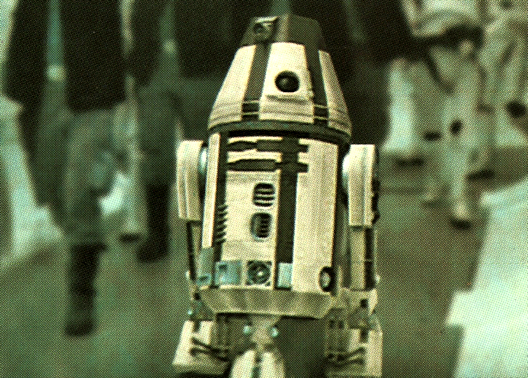Post by Marcus Starkiller on Oct 19, 2006 20:02:32 GMT -5

Flushed with the success of their landmark R2 launch, Industrial Automaton rushed to capitalize on their new dominance of the astromech droid market. The R4-series agromech droid was a highly successful attempt to capture a new market prospect—the Outer Rim Territories urbanite who more likely have a souped-up landspeeder parked in their garage than an X-wing. Accordingly, the R4 was designed for life outside the pristine hangar bay. It was simpler, tougher, and cheaper than previous R-series models.
The R4 had the same outward appearance of R-series droid, below the neck at least, but to save money on production, items such as the video display screen and miniature fire extinguisher were omitted. The holographic projector/recorder unit was retained, but relocated to the top of the head dome to allow for use of a cheaper, less miniaturized unit with a smaller rotational axis. The droid's Intellex VI computer was advanced, but geared toward common repulsorcraft designs and specs for commercially available space transports. The computer brain was designed with more space between the components, lowering production costs, but requiring a larger head dome, and likewise eliminated many of the function indicators and gadgetry found on other R-series head domes. The R4 was unsuited to the task of starfighter astromech; it could only hold the coordinates for a single hyperspace jump in its active memory, a one way trip for any fighter jock. Jedi Temple R4 units, like R4-P17, were notable exceptions, despite their R2-style dome.
The droids were rugged; able to shrug off the nicks and dents common to a working garage environment as well or better than other R-droids. IA was pleased to discover that, with regular maintenance checks, the R4 outlasted its design parameters for operational life, weather endurance, personality matrix stability, and time elapsed between recharge sessions.
Mass-market buyers liked the R4, as did the freedom fighters of the Alliance to Restore the Republic. They reasoned that no one would be suspicious of a mass purchase of agromech droids, the way they would be of starfighter ready copilots like the R2. The model's low cost and knowledge of general-purpose vehicles were also greatly appreciated by the resource-strapped Rebels, and soon the droids' conical heads were familiar sights in Alliance bases and Mon Calamari hangar bays. A few R4s, equipped with non-standard magnetic fault sensors, were used by the Empire to detect flaws and weaknesses in the atmospheric containment fields in hangar bays on board both Death Stars and on Star Destroyers.
